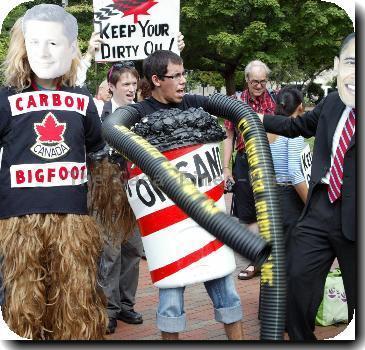BP says more machinery to contain nation’s largest oil spill is on way to Gulf
By Ray Henry, APWednesday, June 9, 2010
BP: More oil-collecting help converging on Gulf
NEW ORLEANS — Help is on the way to bolster the work being done to contain the crude spewing from the bottom of the Gulf of Mexico, including a tanker from the North Sea that will provide an important assist, the point man for the government’s response to the disaster said Wednesday.
The current containment system is catching 630,000 gallons daily, Coast Guard Adm. Thad Allen said at a news briefing in Washington. Officials had previously cited that figure as the system’s general capacity, but Allen said officials now believe it can handle 756,000 gallons daily.
Even so, there’s still more oil eluding capture. BP is bringing in a second vessel that will increase capacity, as well as the North Sea shuttle tanker, which will assist in the transport of the oil, and a device that will burn off some it. The company previously said it plans to switch out the current containment cap with a slightly larger one that will seal better and trap more oil.
The government is also keeping an eye on how BP is reimbursing people for their losses in the Gulf. Allen has written to BP CEO Tony Hayward demanding “more detail and openness” about how the company is handling mounting damage claims, reminding the beleaguered executive that his company “is accountable to the American public for the economic loss caused by the oil spill.”
Among the frustrated is fishing guide Mike Helmer in Metairie, La., outside New Orleans, who worries about paying his bills now that Barataria Bay, one of the richest fishing grounds along the Gulf, is largely shut down by oil taking the form of a widespread sheen complemented by gooey patches of crude.
Helmer said he filed a personal claim with BP several weeks ago and was told recently the company hadn’t even begun on it. He filed a claim on his business just this week.
“If it’s taking this long on my personal claim, who knows for my business?” Helmer said, adding that in the meantime he’ll have no income — nothing.
“Who’s asleep at the wheel here?” he added. “Everything’s too little, too late.”
Allen noted in his letter that he and other officials are meeting with BP later Wednesday to discuss problems with the handling of damage claims related to the April 20 accident.
“We need complete, ongoing transparency into BP’s claims process including detailed information on how claims are being evaluated, how payment amounts are being calculated and how quickly claims are being processed,” Allen wrote.
The government has estimated that around 600,000 to 1.2 million gallons oil are leaking per day, but a scientist on a government team studying the oil flow said Tuesday that his group may determine the daily rate is, in fact, somewhere between 798,000 gallons and 1.8 million gallons.
That means an amount of oil equivalent to two Olympic-size swimming pools might still be escaping daily into the open sea.
The oil now being captured is being pumped to a ship on the surface where workers are burning off the natural gas attached to the crude and shipping the remaining oil to shore. In addition, the British oil giant is preparing to deploy a device called an EverGreen Burner that turns the oil-and-gas mixture into a vapor that is pushed out its 12 nozzles and burned without creating visible smoke.
The burn rig will be moved away from the main leak site so the flames and heat do not endanger other vessels, BP spokesman Max McGahan said Tuesday. He did not know when BP might start using the burner, although company officials have said they want the rig that will carry it to start processing oil by mid-June.
Depending on which model is used and its settings, it can handle 10,500 to 630,000 gallons of oil a day, according to promotional materials by Schlumberger Ltd., the company that makes the device and whose website touts it as producing “fallout-free and smokeless combustion.”
Wilma Subra, a chemist with the Louisiana Environmental Action Network, said BP should avoid burning the captured oil — which she said raises new health risks — and instead bring in more processing equipment.
“This is one of those decisions that will have negative impacts,” she said. “Even though it’s crude dispersed in water, the burning of crude will raise some health issues.”
Officials in President Barack Obama’s administration are talking with BP about a longer-term containment strategy with “built-in redundancies,” Allen said. Obama is scheduled to return to the Gulf Coast on Monday and Tuesday for a two-day update on the spill.
Speaking to network news shows Wednesday morning, BP Chief Operating Officer Doug Suttles continued to insist that no massive underwater oil plumes in “large concentrations” have been detected from the spill. His comments came a day after the government said water tests confirmed underwater oil plumes, but said concentrations were low.
“It may be down to how you define what a plume is here,” Suttles told NBC’s “Today” show. “Those have not been found so far by us or anyone else who’s measured these.”
Suttles continued to dispute scientists’ claims that massive oil plumes have been found. “We haven’t found any large concentrations of oil under the sea,” he told ABC’s “Good Morning America.”
It’s been seven weeks since the BP oil rig explosion that set off the catastrophe. The most recent government estimates put the total amount of oil lost at 23.7 million to 51.5 million gallons, making it by far the nation’s largest oil spill.
Contributing to this report were Associated Press writers Brian Skoloff in Metairie; Eileen Sullvian and Seth Borenstein in Washington; Matthew Brown in Billings, Mont.; and Harry R. Weber in Houston.
Tags: Accidents, Barack Obama, Energy, Environmental Concerns, Louisiana, Metairie, New Orleans, North America, United States


